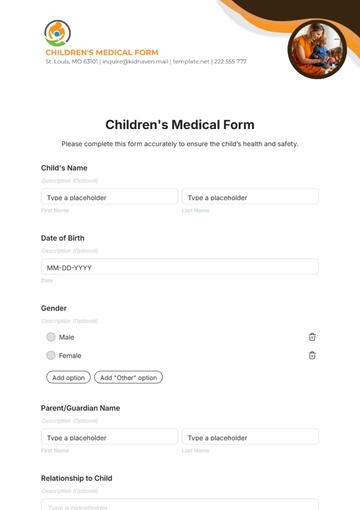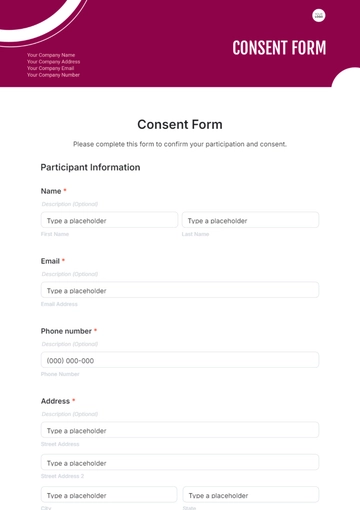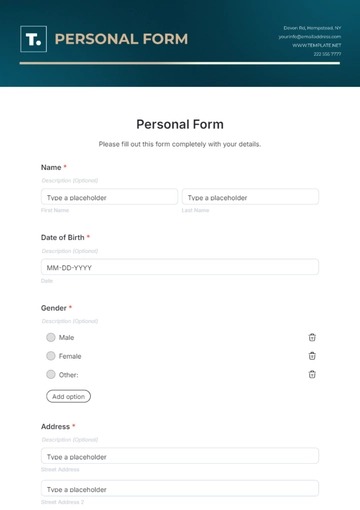Free Operations Customer Retention Strategy Form

Our company recognizes the critical importance of customer retention in sustaining long-term business success. This Operations Customer Retention Strategy Form outlines our approach to retaining customers through effective operational strategies and initiatives.
Customer Segmentation and Analysis
Customer Segment | Description | Needs/Pain Points | Retention Rate (%) |
|---|---|---|---|
Individual Consumers | Residential customers purchasing our products/services for personal use. | Reliable service, personalized experience, competitive pricing. | 85% |
Small Businesses | |||
Enterprise Clients |
Service Quality Standards
Service Standard | Description | Target |
|---|---|---|
Response Time | Acknowledge all customer inquiries within 24 hours. | 24 hours |
Resolution Time | ||
Quality Assurance |
Communication Protocols
Communication Channel | Availability | Frequency | Handling Guidelines |
|---|---|---|---|
Phone | 24/7 | As needed | Handle inquiries with empathy and urgency. |
Live Chat |
V. Feedback Mechanisms
Feedback Mechanism | Description | Frequency | Action Plan |
|---|---|---|---|
Surveys | Quarterly satisfaction surveys sent via email. | Quarterly | Analyze feedback and implement improvements. |
Feedback Forms | Online forms available on the website for suggestions and complaints. | Ongoing | Acknowledge and respond to feedback within 48 hours. |
Social Media Listening | Monitor social media platforms for customer feedback and sentiments. | Real-time | Address issues and engage with customers publicly or privately as appropriate. |
VI. Loyalty Programs and Incentives
Loyalty Program Feature | Description |
|---|---|
Tiered Loyalty Rewards | Offers tiered rewards based on customer engagement and loyalty levels. Benefits increase as customers progress through tiers. |
Exclusive Events and Experiences | Grants access to exclusive events, workshops, and product launches for loyal customers, fostering a sense of belonging and exclusivity. |
Personalized Rewards | Tailors rewards and incentives to individual customer preferences and behaviors using data-driven personalization techniques. |
VII. Problem Resolution Procedures
Problem Resolution Process | Description |
|---|---|
Empowered Support Agents | Support agents empowered with autonomy and resources to resolve customer issues promptly and effectively, minimizing escalations. |
Proactive Issue Resolution | Anticipates potential issues and proactively reaches out to customers to address concerns before they escalate, demonstrating commitment to proactive customer service. |
Continuous Improvement Loop | Operates a continuous improvement loop where insights gained from problem resolution activities are fed back into processes to prevent recurrence. |
VIII. Personalization Strategies
Personalization Strategy | Description |
|---|---|
Dynamic Content Personalization | Delivers dynamic content tailored to individual customer preferences and behavior in real-time, such as content recommendations and promotional offers. |
Predictive Personalization | Anticipates customer needs and preferences before they are expressed, delivering hyper-personalized experiences based on predictive analytics and historical data. |
Contextual Personalization | Contextualizes personalization efforts based on situational factors such as location, device type, and time of day, ensuring relevance and timeliness. |
IX. Data Analysis and Continuous Improvement
Data Analysis and Improvement Approach | Description |
|---|---|
Predictive Analytics for Churn Prevention | Uses predictive analytics to forecast customer churn probabilities and preemptively intervene to retain at-risk customers. |
Root Cause Analysis and Process Optimization | Identifies underlying issues and inefficiencies within operations using root cause analysis techniques, driving process optimization initiatives. |
Agile Experimentation and Iterative Refinement | Adopts an agile experimentation approach to innovation, testing hypotheses through rapid experimentation and iterative refinement to optimize operational processes. |
X. Training and Development
Personalized Learning Paths
Tailored learning paths are provided to employees based on their roles, skill levels, and career aspirations, ensuring personalized and relevant training experiences.
Adaptive learning platforms dynamically adjust course content and difficulty levels based on learner progress and performance.
Gamification and Interactive Learning
Gamification elements are incorporated into training programs to enhance engagement and motivation, transforming learning into a fun and interactive experience.
Leaderboards, badges, and rewards are utilized to incentivize participation and achievement, fostering a culture of continuous learning and improvement.
Mentorship and Coaching
Mentorship and coaching programs are established to provide personalized guidance and support to employees, facilitating skill development and career advancement.
Experienced mentors are paired with mentees to provide one-on-one guidance, feedback, and career advice, nurturing talent and leadership potential within the organization.
- 100% Customizable, free editor
- Access 1 Million+ Templates, photo’s & graphics
- Download or share as a template
- Click and replace photos, graphics, text, backgrounds
- Resize, crop, AI write & more
- Access advanced editor
Discover the ultimate solution for enhancing customer retention with our Operations Customer Retention Strategy Form Template from Template.net. This editable and customizable template empowers you to craft personalized strategies with ease. Utilize the AI Editor Tool to streamline your process and create tailored approaches for every customer segment. Elevate your operations and drive long-term success effortlessly!





























